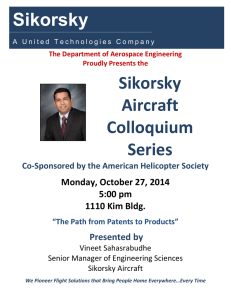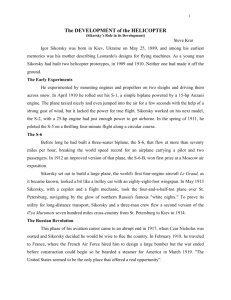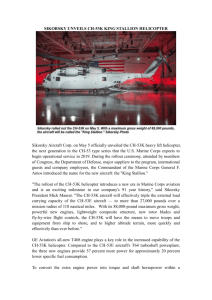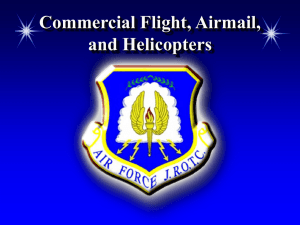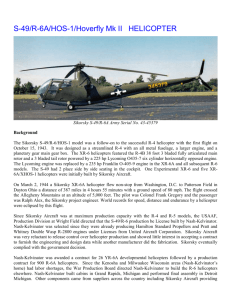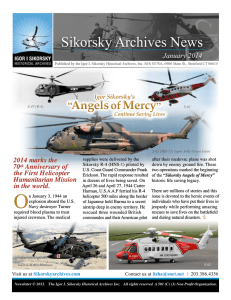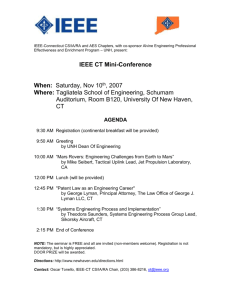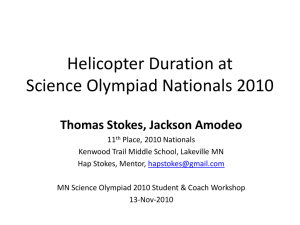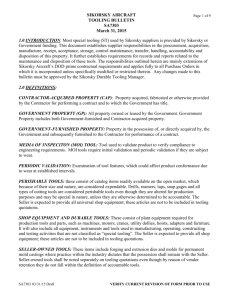Designed to Design – the Business Structure of Sikorsky
advertisement
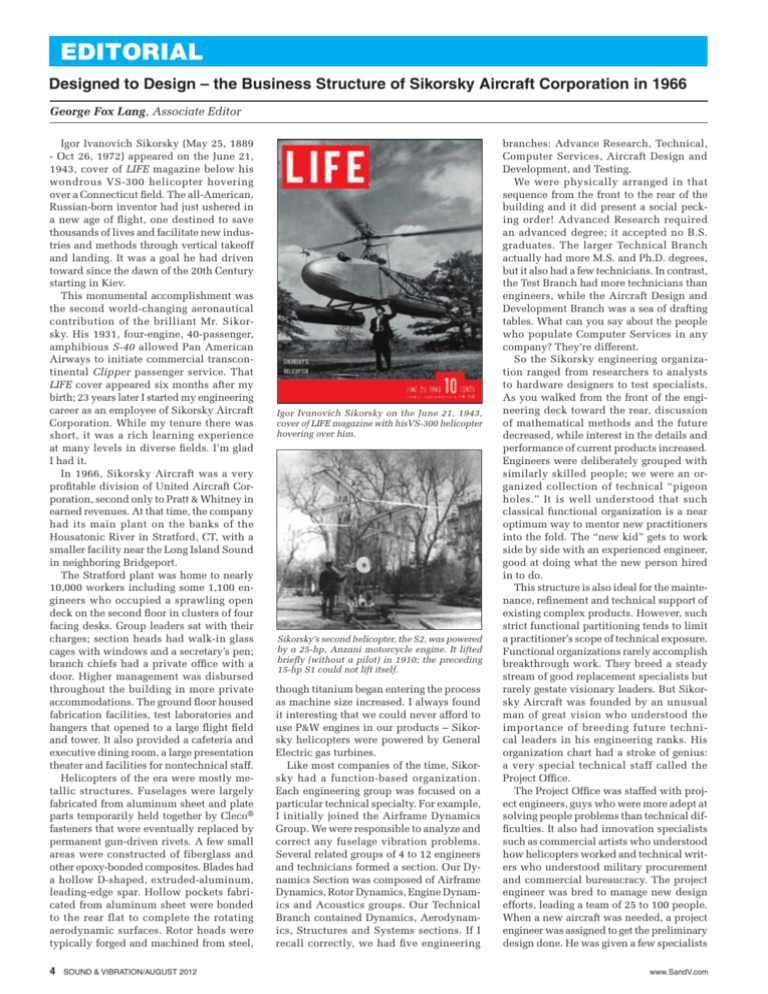
EDITORIAL Designed to Design – the Business Structure of Sikorsky Aircraft Corporation in 1966 George Fox Lang, Associate Editor Igor Ivanovich Sikorsky (May 25, 1889 - Oct 26, 1972) appeared on the June 21, 1943, cover of LIFE magazine below his wondrous VS-300 helicopter hovering over a Connecticut field. The all-American, Russian-born inventor had just ushered in a new age of flight, one destined to save thousands of lives and facilitate new industries and methods through vertical takeoff and landing. It was a goal he had driven toward since the dawn of the 20th Century starting in Kiev. This monumental accomplishment was the second world-changing aeronautical contribution of the brilliant Mr. Sikorsky. His 1931, four-engine, 40-passenger, amphibious S-40 allowed Pan American Airways to initiate commercial transcontinental Clipper passenger service. That LIFE cover appeared six months after my birth; 23 years later I started my engineering career as an employee of Sikorsky Aircraft Corporation. While my tenure there was short, it was a rich learning experience at many levels in diverse fields. I’m glad I had it. In 1966, Sikorsky Aircraft was a very profitable division of United Aircraft Corporation, second only to Pratt & Whitney in earned revenues. At that time, the company had its main plant on the banks of the Housatonic River in Stratford, CT, with a smaller facility near the Long Island Sound in neighboring Bridgeport. The Stratford plant was home to nearly 10,000 workers including some 1,100 engineers who occupied a sprawling open deck on the second floor in clusters of four facing desks. Group leaders sat with their charges; section heads had walk-in glass cages with windows and a secretary’s pen; branch chiefs had a private office with a door. Higher management was disbursed throughout the building in more private accommodations. The ground floor housed fabrication facilities, test laboratories and hangers that opened to a large flight field and tower. It also provided a cafeteria and executive dining room, a large presentation theater and facilities for nontechnical staff. Helicopters of the era were mostly metallic structures. Fuselages were largely fabricated from aluminum sheet and plate parts temporarily held together by Cleco® fasteners that were eventually replaced by permanent gun-driven rivets. A few small areas were constructed of fiberglass and other epoxy-bonded composites. Blades had a hollow D-shaped, extruded-aluminum, leading-edge spar. Hollow pockets fabricated from aluminum sheet were bonded to the rear flat to complete the rotating aerodynamic surfaces. Rotor heads were typically forged and machined from steel, 4 SOUND & VIBRATION/AUGUST 2012 Igor Ivanovich Sikorsky on the June 21, 1943, cover of LIFE magazine with hisVS-300 helicopter hovering over him. Sikorsky’s second helicopter, the S2, was powered by a 25-hp, Anzani motorcycle engine. It lifted briefly (without a pilot) in 1910; the preceding 15-hp S1 could not lift itself. though titanium began entering the process as machine size increased. I always found it interesting that we could never afford to use P&W engines in our products – Sikorsky helicopters were powered by General Electric gas turbines. Like most companies of the time, Sikorsky had a function-based organization. Each engineering group was focused on a particular technical specialty. For example, I initially joined the Airframe Dynamics Group. We were responsible to analyze and correct any fuselage vibration problems. Several related groups of 4 to 12 engineers and technicians formed a section. Our Dynamics Section was composed of Airframe Dynamics, Rotor Dynamics, Engine Dynamics and Acoustics groups. Our Technical Branch contained Dynamics, Aerodynamics, Structures and Systems sections. If I recall correctly, we had five engineering branches: Advance Research, Technical, Computer Services, Aircraft Design and Development, and Testing. We were physically arranged in that sequence from the front to the rear of the building and it did present a social pecking order! Advanced Research required an advanced degree; it accepted no B.S. graduates. The larger Technical Branch actually had more M.S. and Ph.D. degrees, but it also had a few technicians. In contrast, the Test Branch had more technicians than engineers, while the Aircraft Design and Development Branch was a sea of drafting tables. What can you say about the people who populate Computer Services in any company? They’re different. So the Sikorsky engineering organization ranged from researchers to analysts to hardware designers to test specialists. As you walked from the front of the engineering deck toward the rear, discussion of mathematical methods and the future decreased, while interest in the details and performance of current products increased. Engineers were deliberately grouped with similarly skilled people; we were an organized collection of technical “pigeon holes.” It is well understood that such classical functional organization is a near optimum way to mentor new practitioners into the fold. The “new kid” gets to work side by side with an experienced engineer, good at doing what the new person hired in to do. This structure is also ideal for the maintenance, refinement and technical support of existing complex products. However, such strict functional partitioning tends to limit a practitioner’s scope of technical exposure. Functional organizations rarely accomplish breakthrough work. They breed a steady stream of good replacement specialists but rarely gestate visionary leaders. But Sikorsky Aircraft was founded by an unusual man of great vision who understood the importance of breeding future technical leaders in his engineering ranks. His organization chart had a stroke of genius: a very special technical staff called the Project Office. The Project Office was staffed with project engineers, guys who were more adept at solving people problems than technical difficulties. It also had innovation specialists such as commercial artists who understood how helicopters worked and technical writers who understood military procurement and commercial bureaucracy. The project engineer was bred to manage new design efforts, leading a team of 25 to 100 people. When a new aircraft was needed, a project engineer was assigned to get the preliminary design done. He was given a few specialists www.SandV.com Sikorsky amphibians were the transcontinental Clippers of Pan American Airways. from the Project Office and at least one less experienced assistant. A test pilot was also assigned to the team. The project engineer was allowed to draw the bulk of his team from the various specialists within the Engineering Department. In general, his early draws were heavily biased toward the Technical and Advanced Research branches, those people with good conceptualization capabilities and strong mathematical modeling skills. As work progressed, some specialists were dismissed and people with new skills were added. This allowed the team’s skill set to vary during the project without the expense of hiring and firing. It was considered an engineering “badge of honor” to be tapped to serve on such a project. Once tapped, you moved from your normal work place to a new location populated only by members of the project team. You stayed there until your services were no longer required by the project engineer; then you returned to your functional group and its less exciting assignments. In essence, the company would form a small business from its internal assets to accomplish the needed new product design. This allowed Sikorsky to apply the seasoned technical experience of a large organization with the fire and enthusiasm of a new small enterprise. Typical projects lasted anywhere from a few months to well over a year. Product design moved forward www.SandV.com very efficiently. Each week started with a short “all-hands” meeting, where each of the specialist group leaders presented a summary of the prior week’s progress and noted any particular difficulties they were encountering. These were candid presentations, not political ones. The project engineer always made it clear from the start that errors were understood, expected and tolerated; dishonesty never was. Project members quickly bonded, and the work became a coordinated team effort. Frequent and candid communication between all participants was the key to rapid progress, and the project engineer was skilled at making that happen. All of this was done in 1966, long before phrases like “matrix management” fell from anyone’s lips. I had the privilege to serve on two such teams during my three years “below the winged S.” One of these was the response to a U.S. Air Force request for proposal (RFP) for a vehicle they call the Combat Aircrew Recovery Aircraft (CARA). This was to be used to extract downed pilots in Viet Nam. CARA would need to be capable of vertical takeoff and landing but able to fly faster and further than any existing helicopters and have far better fuel efficiency to provide over-target loiter time. The Sikorsky corporate solution was perhaps whimsical – it certainly was complicated. Our proposed craft looked a bit like a DC-3 fuselage with a small gas turbine under each wing. Long doors along the dorsal surface would open to expose a telescoping rotor system driven by free turbines. The general scheme was to take off like a helicopter, accelerate to a transition speed and begin to transfer the lift load from the rotor to the wings by diverting gas from the rotor turbines to the under-wing propulsive fans. Then the rotor would be slowed to a stop, folded, retracted down into the fuselage and covered by the dorsal doors. CARA would then fly rapidly as a fuel-efficient fixed wing craft, locate the downed aircrew and reverse the transition drill to land vertically and rescue them. One of my assigned tasks was to determine how long the conversion between helicopter and airplane would take. This caused me to deal with the details of every team member’s work and actually caused a design revision. Because of a blade resonance problem, a larger rotor brake was needed to slow the rotor more rapidly. To facilitate this, the area of the vertical fin needed to increase, and more hydraulic system capacity was needed. But the most telling input came from the person we expected to fly it. Our assigned test pilot quietly critiqued my work report by saying, “That ain’t gonna work – I can’t hold my breath any more than two minutes!” CARA never flew. In retrospect I wonder if it wasn’t a USAF red herring issued to get a reading on the state of the art at the time. CH-53a Sea Stallion Marine assault helicopter. A Sikorsky S-64 Skycrane carrying a Boeing CH47 Chinook. Two Bell AH-1 Hueys hitch a ride from a Sikorsky S-64 Skycrane. The second project I worked on was called the Advancing Blade Concept (ABC) helicopter, and it did get to fly. All existing Sikorsky helicopters from the tiny VS-300 to the giant S-64 and CH-53 used a single main rotor for lift and propulsion and a smaller tail rotor to react the torque of the main rotor and to control yaw. All of our main rotors used articulated heads; each blade was hinged at the root, allowing it to flap vertically and to lead and lag in the horizontal plane. The ABC was quite different: it eliminated the tail rotor and employed two, three-bladed, coaxial, counter-rotating, rigid rotors. Its small rotor heads did not hinge the blades to flap or lead/lag. While the blade roots, rotor heads, shafts and SOUND & VIBRATION/AUGUST 2012 5 The advancing-blade concept (ABC) prototype in flight. Second-generation ABC aircraft, the X2. 6 SOUND & VIBRATION/AUGUST 2012 bearings did see increased reactions, the fuselage did not experience many of them, since opposing forces from the two rotors balanced one another out. But depending on how the rotors were phased, either a strong 3/rev blade-passage rolling or pitching moment would reach the fuselage. Having the blades cross over the nose cancelled the third harmonic pitching moment, and a hydraulic/pneumatic roll-direction active isolation system filtered out the resulting 3/rev rolling moments. The ABC became the S-69 and first flew on July 26, 1973. It was a sleek looking two-place craft of 12,500 pounds gross weight with 36-footdiameter rotors. Mr. Sikorsky did not live to see the S-69 fly, but I think he would have liked it. In a sense, the coaxial three-bladed rotors would take his design life full circle. The first helicopter he designed and built in 1909 (at age 19 in Kiev, Ukraine) had the same configuration. The S1 didn’t fly – its 15 horsepower Anzani motorcycle engine could not produce enough lift. But his 25 HP S2 of 1910 did lift itself, though not with a pilot. Mr. Sikorsky put his development of a vertical takeoff machine off for 28 years, but he never let that dream die. The author can be contacted at: george@langslair. com. www.SandV.com
